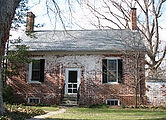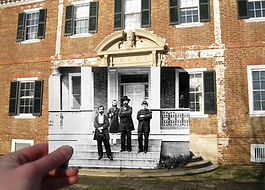THE REST IS HISTORY - YOUR WINDOW INTO THE PAST
Chatham Manor, Fredericksburg, VA
Circa 1768-71
120 Chatham Lane, Fredericksburg, VA 22405
From a hilltop overlooking the Rappahannock River across from the colonial town of Fredericksburg sits Chatham Manor. Named after William Pitt, the Earl of Chatham, the house was built between the years of 1768 and 1771 by William Fitzhugh in the formal Georgian Style. It was the center of a 1280 acre thriving plantation for more than a century. It is also the only private residence that was visited by Presidents George Washington, Thomas Jefferson Abraham Lincoln and Dwight D. Eisenhower.
It originally had dozens of outbuildings including an ice house, dairy, barns, stables and laundry. Along the banks of the river there was a fish hatchery. Also on the estate were a mill, race track and housing for the nearly 100 slaves who worked on the property. In January 105 these slaves overpowered and whipped their overseer and assistants in a minor rebellion which was quickly brought under control by and armed posse of white men. As a result, one slave was killed, two others died trying to escape and two more were deported for their part in the uprising. Soon afterward, owner William Fitzhugh sold the property.
An attempt in 1857 was made by owner Hannah Coalter in her will to free her 93 slaves after making provisions for her elderly handicapped daughter and the slaves. After her relatives protested the will based on the provisions of the Dred Scott Decision, the matter went as far as the Virginia Supreme for resolution. The will was overturned by the state and the estate and its slaves were sold to Hannah’s much younger half-brother J. Horace Lacy. He and his family abandoned the plantation during the Civil War and the home became first the headquarters for the Union Army and later served as a Union hospital. Several graves of soldiers are still evident on the grounds.
The strategic placement along the hilltop overlooking Fredericksburg made it a vitally important site for the Federal troops as they attempted to capture the city. When you visit today, you can view a static display of the kinds of weapons used by the troops in their efforts which unfortunately for them resulted in one of the most decisive victories for the South during the war.
Due to the severe ill use during the war and further disuse after, the property fell into great disrepair. The Lacy family had to sell to pay the taxes on this and their other estate in 1872. A series of wealthy American owners saved the property in the early 20th century and it was refurbished and once again became a beautiful showpiece.
In 1975, it was willed to the National Park Service and now serves as the headquarters for the Fredericksburg and Spotsylvania National Military Park. A visit to the house and grounds is free. Inside the home you will find finely curated displays of photos and information of the history of Chatham Manor. Well trianed docents are available to answer your questions and to guide you in your tour.
One unique feature to notice on the river side of the house are the ghost marks on the brick indicating where previous additions of porches existed as shown in the picture above. The music railing with its lovely line of notes marks the transverse from the upper terrace to the lower.






